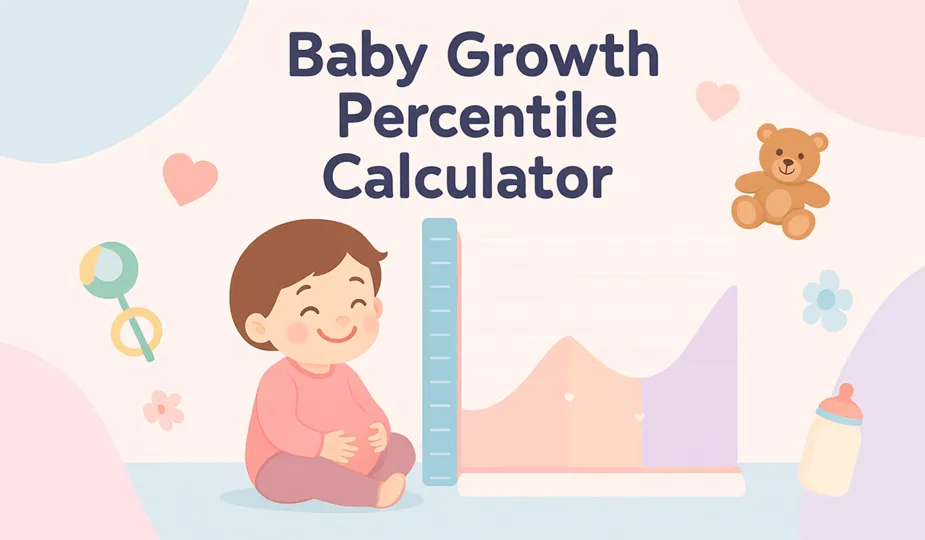Baby Growth Percentile Calculator
Estimate your baby’s growth percentiles for weight, height, and head circumference. Designed with a feminine theme for UK (NHS) guidance, while also relevant globally. For clinical accuracy, always use official growth charts with your healthcare professional.
⇄ Quick Unit Converter
Convert between metric and imperial instantly for weight and length.
Important: This calculator gives an approximate weight-for-age percentile by comparing your baby’s measurements to a simple reference median curve (interpolated). For accurate centile plotting and clinical decisions use official NHS / WHO growth charts and consult your health visitor or paediatrician.
Baby Growth Percentile Calculator
Tracking your baby’s growth is one of the most important ways to understand their health and development. Our free Baby Growth Percentile Calculator makes it easy for parents to estimate how their little one compares to typical growth patterns for their age and sex. Designed to align with NHS guidance for families in the UK, and supported by international standards such as the World Health Organization (WHO), this tool is also helpful for parents across the US and worldwide.
What is a Baby Growth Percentile?
A growth percentile shows how your child’s measurements (such as weight, height/length, and head circumference) compare to other children of the same age and sex. For example, if your baby’s weight is at the 60th percentile, it means they are heavier than 60% of babies their age, and lighter than 40%. Being in a lower or higher percentile does not automatically mean a health issue – it simply provides a reference point for growth trends.
How to Use the Baby Growth Percentile Calculator
Using our calculator is quick and simple. To get an estimated percentile:
- Select your baby’s sex (girl or boy).
- Enter their age in months (from newborn up to five years).
- Choose your preferred measurement system – metric (kg, cm) or imperial (lb, in).
- Enter your baby’s weight, length/height, and optionally head circumference.
- Click “Estimate Percentile” to view results.
The tool will display your child’s approximate growth percentile, the median reference weight, and an easy-to-understand interpretation. You’ll also receive supportive advice to help you understand what the numbers mean.
Why Growth Tracking Matters
Growth is a reliable indicator of a child’s overall health. Regularly tracking your baby’s growth can:
- Highlight whether they are growing consistently over time.
- Provide reassurance when growth follows a steady curve.
- Help healthcare professionals identify potential nutritional or medical concerns early.
- Support parents in making informed decisions about feeding and wellbeing.
It’s important to remember that babies grow at different rates. Genetics, feeding methods (breastfeeding or formula feeding), and even cultural differences can influence how a baby develops.
Features of Our Baby Growth Percentile Calculator
- Easy input: Just a few details give you instant results.
- Supports both metric and imperial units: Useful for UK, US, and international families.
- Interpretation guide: Results include clear explanations to make the data easier to understand.
- Optional PDF download: Save results to share with a midwife, GP, or paediatrician.
- Quick unit converter: Effortlessly switch between pounds/kilograms or inches/centimetres.
Understanding the Results
Percentiles are not a test that a baby “passes” or “fails”. Instead, they show where your child lies within a normal range. For example:
- Below the 10th percentile: Your baby may be smaller than most children their age. This can still be healthy, but growth should be monitored.
- 10th to 90th percentile: This is considered the average range. Babies in this range are usually growing well.
- Above the 90th percentile: Your baby is larger than most of their peers. This might be completely normal but can be discussed during routine check-ups.
Always remember: one percentile reading is less important than the overall growth trend. Consistency is what healthcare professionals look for.
Week-by-Week and Month-by-Month Growth
Babies grow rapidly in their first year, and growth patterns continue to evolve through early childhood:
- Newborn to 3 months: Babies typically gain around 150–200g per week and grow about 2.5–3.5cm each month.
- 3 to 6 months: Weight gain slows slightly to about 100–150g per week, with steady increases in length and head size.
- 6 to 12 months: By their first birthday, most babies will have tripled their birth weight and grown around 25cm in length.
- Toddler years (1–3 years): Growth slows down but remains steady, with around 2kg gained and 12cm added in height each year.
- Preschool years (3–5 years): Growth continues gradually, with weight and height changes becoming more predictable.
Our calculator helps you place these changes in context and can give you extra reassurance between official check-ups.
When to Seek Medical Advice
If your baby’s growth percentile shows a sudden drop or jump, or if you have any concerns about feeding, development, or general health, always speak to your GP, health visitor, or paediatrician. Official NHS growth charts and WHO references should be used for clinical decisions.
Why Parents Around the World Use This Tool
Whether you are a parent in the UK, the US, Europe, or elsewhere, growth calculators are a valuable tool to support your baby’s wellbeing. Our Baby Growth Percentile Calculator is designed with a simple, feminine theme that makes it easy to use and visually engaging, while ensuring accuracy and accessibility across different measurement systems.
Final Thoughts
The Baby Growth Percentile Calculator is not just a tool – it’s a source of reassurance and guidance for parents. By providing an instant estimate of where your child stands compared to peers, it empowers you to stay informed and confident in your parenting journey. Use it regularly to track your baby’s development, and always combine results with professional advice for the best care possible.
